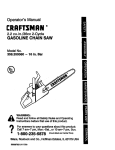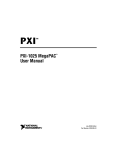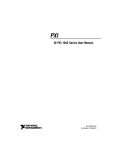Download ADLINK Technology cPCI-6860A Series User`s manual
Transcript
PXIS-3320 PXIS-3320/1000W 15-Slot 6U PXI/CompactPCI Chassis with 500W/1000W Hot-swappable Power Supply User’s Manual Manual Rev. 2.00 Revision Date: October 27, 2006 Part No: 50-17024-1000 Advance Technologies; Automate the World. Copyright 2006 ADLINK TECHNOLOGY INC. All Rights Reserved. Disclaimer The information in this document is subject to change without prior notice in order to improve reliability, design, and function and does not represent a commitment on the part of the manufacturer. In no event will the manufacturer be liable for direct, indirect, special, incidental, or consequential damages arising out of the use or inability to use the product or documentation, even if advised of the possibility of such damages. This document contains proprietary information protected by copyright. All rights are reserved. No part of this manual may be reproduced by any mechanical, electronic, or other means in any form without prior written permission of the manufacturer. Trademark Information PXI is registered trademarks of PXI Systems Alliance. Other product names mentioned herein are used for identification purposes only and may be trademarks and/or registered trademarks of their respective companies. Getting service from ADLINK Customer satisfaction is our top priority. Contact us should you require any service or assistance. ADLINK TECHNOLOGY INC. Web Site: Sales & Service: TEL: FAX: Address: http://www.adlinktech.com [email protected] +886-2-82265877 +886-2-82265717 9F, No. 166, Jian Yi Road, Chungho City, Taipei, 235 Taiwan E-mail or fax this completed service form for prompt and satisfactory service. Company Information Company/Organization Contact Person E-mail Address Address Country TEL FAX: Web Site Product Information Product Model Environment OS: M/B: Chipset: CPU: BIOS: Please give a detailed description of the problem(s): Table of Contents List of Tables.......................................................................... iii List of Figures ......................................................................... v 1 Introduction ........................................................................ 1 1.1 1.2 Features............................................................................... 2 Unpacking Checklist ............................................................ 3 2 Chassis Overview............................................................... 5 2.1 2.2 2.3 2.4 2.5 Front View............................................................................ 5 Right View............................................................................ 7 Top View.............................................................................. 7 Rear View ............................................................................ 8 Backplane overview............................................................. 9 System Controller Slot .................................................... 9 Star Trigger Slot ............................................................ 10 Peripheral Slots ............................................................ 10 Local Bus ...................................................................... 10 Trigger Bus ................................................................... 10 10 MHz Reference Clock .............................................. 11 3 Installation ........................................................................ 13 3.1 3.2 3.3 3.4 3.5 3.6 3.7 Calculating Power Consumption........................................ Installing the Chassis and Starting Up............................... Monitoring the System ....................................................... Alarms................................................................................ Grounding the Chassis ...................................................... Changing the Power Supply Modules................................ Changing the Fans ............................................................ 13 14 15 15 16 16 17 4 Troubleshooting and Preventive Maintenance .......................................................................... 19 4.1 4.2 Troubleshooting for Power Failure of PXIS-3320 .............. 19 Cleaning............................................................................. 20 Cleaning the Chassis Interior ........................................ 20 Cleaning the Chassis Exterior ...................................... 20 Table of Contents i A Specifications.................................................................... 21 A.1 A.2 A.3 A.4 A.5 A.6 A.7 A.8 A.9 General .............................................................................. 21 Power Supply..................................................................... 21 System Monitoring ............................................................. 22 System LEDs ................................................................ 22 Buzzer/Alarm ................................................................ 22 Cooling System.................................................................. 22 Physical.............................................................................. 23 Operating Environment ...................................................... 23 Backplane .......................................................................... 23 Shock and Vibration........................................................... 23 Safety and EMC/EMI Compliance ..................................... 23 B Backplane Drawing and Pin Assignments ..................... 25 B.1 B.2 B.3 B.4 B.5 Backplane Layout .............................................................. 25 Backplane CBX-6015 Connectors Pin Assignments ...................................................... 27 PXI Connectors Pin Assignments ................................. 27 Bus Segments and Interrupt Routings ............................... 33 Bus Segments and Interrupt Routings ............................... 34 Miscellaneous Connectors Pin Assignments ..................... 35 CN1, CN7, CN8, CN9: ATX-like DC Power input connectors ................................................. 35 PCI VIO Selection Screw Terminals ............................. 35 J6 INH#: DC power inhibit signal .................................. 36 J8 RST#: System reset signal ...................................... 36 J9 FAL#: Power supply fail input .................................. 36 J5: Connector for LED power status ............................. 36 CN5: SMB (System Management Bus) connector ...... 37 JP1: 10 MHz Reference Clock ...................................... 37 J2: POWER SENSE ..................................................... 37 Important Safety Instructions............................................... 39 Warranty Policy ..................................................................... 41 ii Table of Contents List of Tables Table 3-1: LED indications ....................................................... 15 Table 4-1: Troubleshooting Power Failures ............................. 19 List of Tables iii List of Figures Figure 2-1: Figure 2-2: Figure 2-3: Figure 2-4: Figure 2-5: Figure 2-6: Figure B-1: Figure B-2: v PXIS-3320 front view ................................................. 5 PXIS-3320/1000W front view..................................... 6 PXIS-3320 and PXIS/1000W right view..................... 7 PXIS-3320 and PXIS/1000W top view....................... 7 PXIS-3320 and PXIS-3320/1000W rear view ............ 8 Backplane functions................................................... 9 CBX-6015 front view................................................ 25 CBX-6015 rear view................................................. 26 List of Figures 1 Introduction The ADLINK PXIS-3320 is a 19" 6U PXI chassis featuring one system slot and 14 PXI peripheral slots. The chassis is compliant with PXI and CompactPCI specifications and accommodates both 6U PXI and CompactPCI modules. An internal 10 MHz reference clock is available on all of the 14 PXI peripheral slots, as well as star trigger, PXI trigger bus, and PXI local bus. These functions are dedicated for users to facilitate synchronization among multiple peripheral modules. The PXIS-3320 series is equipped with industrial-grade, PICMG 2.11-compliant CompactPCI power modules to provide reliable power and easy maintenance. The standard PXIS-3320 is equipped with two power modules to provide up to 500 W of power. Designed to support high-power configurations, the PXIS3320/1000W model provides sufficient and reliable power supply to power-intensive peripherals such as high-speed digitizers, digital pin driver/receiver, and communication modules. The system power supply, temperature, and cooling fan statuses are monitored by the alarm module onboard the chassis. When a component failure is detected, corresponding LED and buzzer alarms are activated for rapid maintenance and/or replacement. To guarantee operating stability, two decks of hot-swappable fan trays are available to create a superb 482 CFM airflow that effectively exhausts all heat generated inside the chassis. Defective fans may be easily removed from the front panel of the chassis, thus effectively reducing MTTR (Mean-Time-To-Repair). It is recommended that you use the cPCI-6840 and cPCI-6860A controllers for the PXIS-3320 chassis. These high-performance controllers are ideal for the development of applications within the PXIS-3320. You may also deploy ADLINK’s PCI-8570 or PXI8570/6U PCI-to-PXI extension module to remotely control the PXIS-3320 via a host computer. Introduction 1 1.1 Features 2 X Supports both 6U PXI and CompactPCI modules X PXI specifications Rev. 2.2-compliant X Supports one system slot and 14 PXI/CompactPCI peripheral slots X Two hot-swappable 250 W CompactPCI power supply with universal AC input (PXIS-3320) X Filtered, forced-air cooling architecture X Magnetic circuit breaker protection for AC input X Temperature, voltage, and fan monitoring LEDs X Optional 1000 W power supply (PXIS-3320/1000W) Introduction 1.2 Unpacking Checklist Before unpacking, check the shipping carton for any damage. If the shipping carton and/or contents are damaged, inform your dealer immediately. Retain the shipping carton and packing materials for inspection. Obtain authorization from your dealer before returning any product to ADLINK. Check if the following items are included in the package. PXIS-3320 X 6U PXI/CompactPCI chassis with 15 slots and two cPS-H325/AC power supply modules X Power cord X User’s manual PXIS-3320/1000W X 6U PXI/CompactPCI chassis with 15 slots and four cPS-H325/AC power supply modules X Power cord X User’s manual NOTE Introduction The PXIS-3320 OEM version package may vary depending on customer requests. The assigned controller and/or peripheral modules may be pre-installed and shipped with the chassis. Inquire with your dealer for additional information on these options. 3 4 Introduction 2 Chassis Overview This section illustrates the mechanical dimensions of the PXIS3320 and PXIS-3320/1000W chassis, identifies the basic, and describes the backplane functions and features. 2.1 Front View Fan tray cover screw Fan tray cover Alarm reset button Power switch LEDs Fan tray cover Power supply modules Figure 2-1: PXIS-3320 front view Chassis Overview 5 Fan tray cover screw Fan tray cover Alarm reset button Power switch LEDs Fan tray cover Power supply modules Figure 2-2: PXIS-3320/1000W front view 6 Chassis Overview 2.2 Right View Handle Figure 2-3: PXIS-3320 and PXIS/1000W right view 2.3 Top View Figure 2-4: PXIS-3320 and PXIS/1000W top view Chassis Overview 7 2.4 Rear View Circuit breaker Power connector Figure 2-5: PXIS-3320 and PXIS-3320/1000W rear view 8 Chassis Overview 2.5 Backplane overview The PXIS-3320 chassis comes with a 6U, 15-slot PXI backplane that supports one PXI system controller and 14 PXI/CompactPCI peripheral modules. This section illustrates the functions of the backplane. Clock 10 MHz Buffer Circuitry Local Local 3 Local 4 Local B Local 5 … Peripheral slot Peripheral slot Peripheral slot Peripheral slot Peripheral slot Star Trigger Controller 1 2 Peripheral slot System Controller PXI Star Local 13 14 PXI Trigger Bus Segment and PCI Bus Segment Figure 2-6: Backplane functions System Controller Slot As defined by PXI specifications, the system controller slot occupies Slot 1 of the chassis. The system slot occupies two units of slot space and accommodates either a 1-slot or 2-slot 6U PXI/ cPCI system controller. It is recommended that you use ADLINK cPCI-6840 and cPCI-6860A system controller for the PXIS-3320 chassis. Chassis Overview 9 Star Trigger Slot Slot 2 is designated as the Star Trigger (ST) slot. This slot features a dedicated trigger line between itself and slots 3 to 15. The star trigger delivers trigger signals with ultra-low skew (<1ns) to peripheral modules. To use the star trigger functionality, you must install a special star trigger controller in Slot 2. Peripheral Slots The PXIS-3320 chassis backplane accommodates up to fourteen 6U PXI/CompctPCI peripheral modules. Local Bus The PXI backplane’s local bus is a daisy-chained bus that connects each peripheral slot with the slots on its left and right. Each local bus is 14 lines wide and can pass analog and digital signals between modules or provide a high-speed, sideband communication path that does not affect the PCI bandwidth. Following PXI specifications, the local bus connects all adjacent slots except Slots 1 and 2. Trigger Bus The backplane’s trigger bus is an 8-line bus that connects all slots in the same PCI segment. Users can use triggers to synchronize the operation of several PXI peripheral modules, or use one module to control accurate timing sequences of operations performed on other modules in the system. Modules can pass trigger signals or clock signals to other modules through the trigger bus, allowing precise timed responses to asynchronous external events that the system is monitoring or controlling. 10 Chassis Overview 10 MHz Reference Clock The backplane supplies every peripheral slot with a 10 MHz system clock signal (PXI_CLK10). An independent clock buffer (having source impedance matched to the backplane and a skew of <1ns between slots) drives the clock signals to each peripheral slot. You can use this common reference clock signal to synchronize multiple modules in a measurement or control system or drive PXI_CLK10 from an external source through the PXI_CLK10_IN pin on the P2 connector of the star trigger slot. Chassis Overview 11 12 Chassis Overview 3 Installation The chapter describes the procedures on how to install the system controller to the PXIS-3320 chassis. It also provides information on how to power up and monitor the system. 3.1 Calculating Power Consumption Before installing any modules into the PXIS-3320 chassis, calculate the total system power requirement and check the power saving requirements for each DC power source including the +5 V, +3.3 V, +12 V, and -12 V supply rail. Refer to Appendix A for the maximum usable power. Installation 13 3.2 Installing the Chassis and Starting Up Follow the steps to power on the chassis. 1. For rackmount or bench-top installation, provide a sufficient space under the chassis for ventilation and make sure that the chasis is installed on a flat and stable surface. 2. Put the power switch in the standby (OFF) position. The power switch protrudes from the bezel when the system is in standby power mode. Refer to the illustration below. The front-panel power switch turns the system ON or OFF. 3. Plug the AC power cord to a properly grounded wall socket or power strip. 4. Make sure that the CPU, memory modules, and storage device are properly installed on the system controller module. 5. Push down (loose) the ejector/injector handles of the system controller module. 6. Align the system controller module’s top and bottom edges to the card guides. 7. Carefully slide the system controller module into the chassis, then push the ejector/injector handle up to secure the module in place. Secure the module with screws from the chassis front panel. 8. Install additional 6U PXI/CompactPCI peripheral modules, if needed. 14 Installation 9. Press the power switch. The amber LED and green LEDs on the upper right corner of the front panel light up. The chassis fans also start to rotate. NOTE Installation If the chassis fails to turn on, refer to Chapter 4: Troubleshooting and Preventive Maintenance for details. 15 3.3 Monitoring the System Light Emitting Diodes (LEDs) on the front panel tell you the power status, chassis temperature, and fan operations. Refer to Table 31 for details. LED Power Function DC rail voltages (+3.3 V, +5 V, +12 V, -12 V) Internal temperature Temperature status Fan Fan speeds and operation Color Status ON Power is supplied to the system OFF No power is supplied to the system ON Internal temperature is less than 50ºC Flashing internal temperature is more than 50ºC Green Red ON Amber Indication Flashing Fan speed is normal Fan speed is abnormal; fan is defective Table 3-1: LED indications 3.4 Alarms The chassis comes with an alarm buzzer and an alarm reset button. The alarm buzzer beeps to alert you of any power, temperature, or fan failure. The alarm reset button resets the alarm monitor system and stops the buzzer. 16 Installation 3.5 Grounding the Chassis The backplane’s mounting holes may be grounded in two ways. First, the mounting holes labeled as GND with circle soldering mask can be connected to the signal ground plane of the backplane. Second, the mounting holes labeled as FGND with square soldering mask can be connected to the power ground plane (the earth), and is isolated from the signal ground. A proper signal and power wiring helps reduce the effects of ground loop and increases the accuracy of measurement. By default, the PXIS-3320 backplane is mounted on the chassis through the FGND mounting holes. The signal ground (GND), therefore, is isolated to the power ground (FGND). For applications that require the short of signal ground and power ground, an external wiring is needed to connect the GND and FGND soldering pots. 3.6 Changing the Power Supply Modules The PXIS-3320 chassis comes with two 3U CompactPCI power supply modules, while the PXIS-3320/1000W chassis comes with four 3U CompactPCI power supply modules. The power supply modules are current-sharing and are hot-swappable. To replace the power modules: 1. Release the handle of the defective power module. 2. Push down the handle to eject the power module from the chassis. 3. Carefully pull the power module out from the chassis, then set aside. 4. Align the top and bottom edges of power supply modules to the card guides, then install the power supply module into the chassis. 5. Use the handle to firmly connect the power module into the chassis backplane. Installation 17 3.7 Changing the Fans The PXIS-3320 chassis has ten 80 mm x 80 mm x 25 mm fans. These fans are installed in two decks of fan trays. Five fans are located at the bottom of the chassis for air intake, while the other five fans are installed on top of the chassis for air ventilation. The fan trays are hot-swappable. When a fan fails to operate, the alarm buzzer beeps and the fan LED flashes to alert you. Reset the alarm by pressing the alarm reset button, then replace the defective fan. To replace a defective fan: 1. Remove the fan tray cover by loosening the thumb screw. 2. Check the LED in front of each fan tray. The LED blinks when the fan is defective. 3. Remove two screws that secure the fan tray to the chassis, then carefully pull the tray out of the chassis. 4. Install a new fan into the tray, then secure it with two screws you earlier removed. 5. Replace the fan tray cover. 18 Installation 4 Troubleshooting and Preventive Maintenance 4.1 Troubleshooting for Power Failure of PXIS-3320 When the PXI-3320 chassis fails to turn on, refer to Table 4-1 for basic power troubleshooting. The table lists the most common cause for power failure and the recommends proces to correct the problem. Possible Causes The power cord is not connected to the power outlet. What to Do Make sure that the power cord is connected to a properly grounded and live electrical outlet. Try connecting another electrical equipment to this outlet to make sure that it has power. Power switch is not at ON Set the power switch to the ON position. position. The circuit breaker is not at ON position. Make sure to turn off the power switch before setting the circuit breaker to ON position. After turning the circuit breaker on, turn the power switch on. Power supply has failed. Check the LED indicators on the CompactPCI power supply modules. If the POWER LED is off or the FAULT LED lights up orange when you press the power switch, the power supply module may be damaged. Contact an ADLINK representative for more information. Table 4-1: Troubleshooting Power Failures Troubleshooting and Preventive Maintenance 19 4.2 Cleaning It is recommended that you clean the interior and exterior of the PXIS-3320 chassis regularly. To clean individual CompactPCI or PXI modules, refer to the documentation that came with the module. NOTE Always turn the chassis off and disconnect the power cord from the electrical socket before cleaning the chassis. Cleaning the Chassis Interior Use a dry, low-velocity stream of air to clean the interior of the chassis. Clean around components with a soft-bristle brush. If you must use liquid for minor interior cleaning, use a 75% isopropyl alcohol solution, then rinse the area with de-ionized water. Cleaning the Chassis Exterior Use a dry lint-free cloth or a soft-bristle brush to clean the exterior surfaces of the chassis. To remove dirt, moisten a cloth with a mild soap solution to wipe the exterior surfaces of the chassis. To remove any soap residue, wipe the surface with a cloth moistened with clean water. Do not use abrasive compounds to clean any part of the chassis. 20 Troubleshooting and Preventive Maintenance A Specifications A.1 General Complies with PXI specifications and accepts modules compliant with CompactPCI, PICMG 2.0 specifications. A.2 Power Supply X PICMG standards: PICMG 2.11-compliant X Input voltage: 100 to 240 VAC X Input frequency: 47 to 63 Hz X Output: 250 W (each) Specifications VDC Typical Maximum +5 V 25.0 A 33.0 A +3.3 V 18.0 A 33.0 A +12 V 5.0 A 5.5 A -12 V 0.5 A 1A 21 A.3 System Monitoring System LEDs LED Function/Setting Status Indication Power Voltage monitoring of +3.3 V, +5 V, +12 V, -12 V ON Power is supplied Temperature monitoring. 50°C (default setting) ON Temperature is normal Temperature FLASHING Temperature exceeds normal settings Fan speed monitoring ON Normal fan speed Fan FLASHING Fan is not working or has malfunctioned Buzzer/Alarm Alarm/ Buzzer Function Alarm buzzer Beeps when any alarm occurs Alarm reset button Resets the alarm monitor system A.4 Cooling System Front-access hot-swappable fan trays for air intake and ventilation 22 X Type: 12 VDC brush-less, dual-ball bearing X Five fans for air intake and five fans for ventilation X Rated fan speed: 4000 to 5000 RPM X Rated fan power: 2.64W X Airflow for intake: 241 CFM X Airflow for ventilation: 241 CFM Specifications A.5 Physical X Number of slots: 15 (one system slot, 14 peripheral slots) X Dimensions: 484 mm x 295 mm x 398 mm (L x W x H) without handles X Weight: 23 kg A.6 Operating Environment Ambient temperature range Model Temperature PXIS-3320 0 to 50°C PXIS-3320/1000W 0 to 50°C Relative humidity: 10 to 90%, non-condensing A.7 Backplane X Backplane bare-board material: UL 94V-0 rated X Backplane connectors: Conforms to IEC-917 and IEC 10764-101, UL 94V-0 rated A.8 Shock and Vibration X Shock: 15 G peak-to-peak, 11 ms duration, non-operation X Random Vibration Z Operating: 5 to 500 Hz, 0.5 GRMS each axis Z Nonoperating: 5 to 500 Hz, 1.88 GRMS each axis A.9 Safety and EMC/EMI Compliance EMC/EMI: CE, FCC Class A Specifications 23 24 Specifications B Backplane Drawing and Pin Assignments B.1 Backplane Layout The following figures show the front and rear view of the PXIS3320 backplane. . Figure B-1: CBX-6015 front view Backplane Drawing and Pin Assignments 25 . Figure B-2: CBX-6015 rear view 26 Backplane Drawing and Pin Assignments B.2 Backplane CBX-6015 Connectors Pin Assignments PXI Connectors Pin Assignments System Slot (Slot #1) P1 Pin Assignment Pin Z A B C D E F 25 GND +5V REQ64# ENUM# +3.3V +5V GND 24 GND AD[1] +5V V(I/O) AD[0] ACK64# GND 23 GND +3.3V AD[4] AD[3] +5V AD[2] GND 22 GND AD[7] GND +3.3V AD[6] AD[5] GND 21 GND +3.3V AD[9] AD[8] GND C/BE[0]# GND 20 GND AD[12] GND V(I/O) AD[11] AD[10] GND 19 GND +3.3V AD[15] AD[14] GND AD[13] GND 18 GND SERR# GND +3.3V PAR C/BE[1]# GND 17 GND +3.3V IPMB_SCL IPMB_SDA GND PERR# GND 16 GND DEVSEL# GND V(I/O) STOP# LOCK# GND 15 GND +3.3V FRAME# IRDY# GND TRDY# GND 12-14 Key 11 GND AD[18] AD[17] AD[16] GND C/BE[2]# GND 10 GND AD[21] GND +3.3V AD[20] AD[19] GND GND 9 GND C/BE[3]# GND AD[23] GND AD[22] 8 GND AD[26] GND V(I/O) AD[25] AD[24] GND 7 GND AD[30] AD[29] AD[28] GND AD[27] GND 6 GND REQ# (1) GND +3.3V CLK (1) AD[31] GND 5 GND BRSVP1A5 BRSVP1B5 PCIRST# GND GNT# (1) GND 4 GND IPMB_PWR GND V(I/O) INTP INTS GND 3 GND INTA# (1) INTB# (1) INTC# (1) +5V INTD# (1) GND 2 GND TCK +5V TMS TDO TDI GND 1 GND +5V -12V TRST# +12V +5V GND Pin Z A B C D E F Backplane Drawing and Pin Assignments 27 System Slot (Slot #1) P2 Pin Assignment Pin Z A B C D E F 22 GND PXI_BRSVA22 PXI_BRSVB22 PXI_BRSVC22 PXI_BRSVD22 PXI_BRSVE22 GND 21 GND CLK6 GND NC NC NC GND 20 GND CLK5 GND NC GND NC GND 19 GND GND GND SMBDATA SMBCLK SMBALERT- GND 18 GND PXI_TRIG3 PXI_TRIG4 PXI_TRIG5 GND PXI_TRIG6 GND 17 GND PXI_TRIG2 GND PRST# REQ6# GNT6# GND 16 GND PXI_TRIG1 PXI_TRIG0 DEG# GND PXI_TRIG7 GND 15 GND PXI_BRSVA15 GND FAL# REQ5# GNT5# GND 14 GND AD[35] AD[34] AD[33] GND AD[32] GND 13 GND AD[38] GND V(I/O) AD[37] AD[36] GND 12 GND AD[42] AD[41] AD[40] GND AD[39] GND 11 GND AD[45] GND V(I/O) AD[44] AD[43] GND 10 GND AD[49] AD[48] AD[47] GND AD[46] GND 9 GND AD[52] GND V(I/O) AD[51] AD[50] GND 8 GND AD[56] AD[55] AD[54] GND AD[53] GND 7 GND AD[59] GND V(I/O) AD[58] AD[57] GND 6 GND AD[63] AD[62] AD[61] GND AD[60] GND 5 GND C/BE[5]# GND V(I/O) C/BE[4]# PAR64 GND 4 GND V(I/O) PXI_BRSVB4 C/BE[7]# GND C/BE[6]# GND 3 GND CLK4 GND GNT3# REQ4# GNT4# GND 2 GND CLK2 CLK3 GND (SYS#) GNT2# REQ3# GND 1 GND CLK1 GND REQ1# GNT1# REQ2# GND Pin Z A B C D E F 28 Backplane Drawing and Pin Assignments Star Trigger Slot (Slot #2) P1 Pin Assignment Pin Z A B C D E F 25 GND +5V REQ64# ENUM# +3.3V +5V GND 24 GND AD[1] +5V V(I/O) AD[0] ACK64# GND 23 GND +3.3V AD[4] AD[3] +5V AD[2] GND 22 GND AD[7] GND +3.3V AD[6] AD[5] GND GND 21 GND +3.3V AD[9] AD[8] M66EN C/BE[0]# 20 GND AD[12] GND V(I/O) AD[11] AD[10] GND 19 GND +3.3V AD[15] AD[14] GND AD[13] GND 18 GND SERR# GND +3.3V PAR C/BE[1]# GND 17 GND +3.3V IPMB_SCL IPMB_SDA GND PERR# GND 16 GND DEVSEL# GND V(I/O) STOP# LOCK# GND 15 GND +3.3V FRAME# IRDY# GND TRDY# GND 12-14 Key GND 11 GND AD[18] AD[17] AD[16] GND C/BE[2]# 10 GND AD[21] GND +3.3V AD[20] AD[19] GND 9 GND C/BE[3]# IDSEL (1) AD[23] GND AD[22] GND 8 GND AD[26] GND V(I/O) AD[25] AD[24] GND 7 GND AD[30] AD[29] AD[28] GND AD[27] GND 6 GND REQ# (1) GND +3.3V CLK (1) AD[31] GND 5 GND BRSVP1A5 BRSVP1B5 PCIRST# GND GNT# (1) GND 4 GND IPMB_PWR GND V(I/O) INTP INTS GND 3 GND INTA# (1) INTB# (1) INTC# (1) +5V 2 GND TCK +5V TMS TDO TDI GND 1 GND +5V -12V TRST# +12V +5V GND Pin Z A B C D E F Backplane Drawing and Pin Assignments INTD# (1) GND 29 Star Trigger Slot (Slot #2) P2 Pin Assignment Pin Z A B C D E F 22 GND PXI_BRSVA22 PXI_BRSVB22 PXI_BRSVC22 PXI_BRSVD22 PXI_BRSVE22 GND PXI_LBR3 GND 21 GND PXI_LBR0 GND PXI_LBR1 PXI_LBR2 20 GND PXI_LBR4 PXI_LBR5 PXI_STAR0 (2) GND 19 GND PXI_STAR2 (2) GND PXI_STAR3 (2) PXI_STAR4 PXI_STAR5 18 GND PXI_TRIG3 PXI_TRIG4 PXI_TRIG5 GND PXI_TRIG6 GND 17 GND PXI_TRIG2 GND N/C PXI_CLK10_IN PXI_CLK10 GND 16 GND PXI_TRIG1 PXI_TRIG0 N/C GND PXI_TRIG7 GND 15 GND PXI_BRSVA15 GND N/C PXI_STAR6 PXI_LBR6 GND 14 GND AD[35] AD[34] AD[33] GND AD[32] GND 13 GND AD[38] GND V(I/O) AD[37] AD[36] GND 12 GND AD[42] AD[41] AD[40] GND AD[39] GND PXI_STAR1 (2) GND GND 11 GND AD[45] GND V(I/O) AD[44] AD[43] GND 10 GND AD[49] AD[48] AD[47] GND AD[46] GND 9 GND AD[52] GND V(I/O) AD[51] AD[50] GND 8 GND AD[56] AD[55] AD[54] GND AD[53] GND 7 GND AD[59] GND V(I/O) AD[58] AD[57] GND 6 GND AD[63] AD[62] AD[61] GND AD[60] GND 5 GND C/BE[5]# GND V(I/O) C/BE[4]# PAR64 GND 4 GND V(I/O) PXI_BRSVB4 C/BE[7]# GND C/BE[6]# GND 3 GND PXI_LBR7 GND PXI_LBR8 PXI_LBR9 PXI_LBR10 GND 2 GND PXI_LBR11 PXI_LBR12 N.C (SYS#) PXI_STAR7 PXI_STAR8 GND 1 GND PXI_STAR9 GND PXI_STAR10 PXI_STAR11 PXI_STAR12 GND Pin Z A B C D E F 30 Backplane Drawing and Pin Assignments General Peripheral Slot (Slot #3~#15) P1 Pin Assignment Pin Z A B C D E F 25 GND +5V REQ64# ENUM# +3.3V +5V GND 24 GND AD[1] +5V V(I/O) AD[0] ACK64# GND 23 GND +3.3V AD[4] AD[3] +5V AD[2] GND 22 GND AD[7] GND +3.3V AD[6] AD[5] GND 21 GND +3.3V AD[9] AD[8] M66EN C/BE[0]# GND 20 GND AD[12] GND V(I/O) AD[11] AD[10] GND 19 GND +3.3V AD[15] AD[14] GND AD[13] GND 18 GND SERR# GND +3.3V PAR C/BE[1]# GND 17 GND +3.3V IPMB_SCL IPMB_SDA GND PERR# GND 16 GND DEVSEL# GND V(I/O) STOP# LOCK# GND 15 GND +3.3V FRAME# IRDY# GND TRDY# GND 12-14 Key 11 GND AD[18] AD[17] AD[16] GND C/BE[2]# GND 10 GND AD[21] GND +3.3V AD[20] AD[19] GND 9 GND C/BE[3]# IDSEL (1) AD[23] GND AD[22] GND 8 GND AD[26] GND V(I/O) AD[25] AD[24] GND 7 GND AD[30] AD[29] AD[28] GND AD[27] GND 6 GND REQ# (1) GND +3.3V CLK (1) AD[31] GND 5 GND BRSVP1A5 BRSVP1B5 PCIRST# GND GNT# (1) GND 4 GND IPMB_PWR GND V(I/O) INTP INTS GND 3 GND INTA# (1) INTB# (1) INTC# (1) +5V INTD# (1) GND 2 GND TCK +5V TMS TDO TDI GND 1 GND +5V -12V TRST# +12V +5V GND Pin Z A B C D E F Backplane Drawing and Pin Assignments 31 General Peripheral Slot (Slot #3~#15) P2 Pin Assignment Pin Z A B C D E F 22 GND PXI_BRSVA22 PXI_BRSVB22 PXI_BRSVC22 PXI_BRSVD22 PXI_BRSVE22 GND 21 GND PXI_LBR0 GND PXI_LBR1 PXI_LBR2 PXI_LBR3 GND 20 GND PXI_LBR4 PXI_LBR5 PXI_LBL0 GND PXI_LBL1 GND 19 GND PXI_LBL2 GND PXI_LBL3 PXI_LBL4 PXI_LBL5 GND 18 GND PXI_TRIG3 PXI_TRIG4 PXI_TRIG5 GND PXI_TRIG6 GND 17 GND PXI_TRIG2 GND N/C PXI_STAR (2) PXI_CLK10 GND 16 GND PXI_TRIG1 PXI_TRIG0 N/C GND PXI_TRIG7 GND GND 15 GND PXI_BRSVA15 GND N/C PXI_LBL6 PXI_LBR6 14 GND AD[35] AD[34] AD[33] GND AD[32] GND 13 GND AD[38] GND V(I/O) AD[37] AD[36] GND 12 GND AD[42] AD[41] AD[40] GND AD[39] GND 11 GND AD[45] GND V(I/O) AD[44] AD[43] GND 10 GND AD[49] AD[48] AD[47] GND AD[46] GND 9 GND AD[52] GND V(I/O) AD[51] AD[50] GND 8 GND AD[56] AD[55] AD[54] GND AD[53] GND 7 GND AD[59] GND V(I/O) AD[58] AD[57] GND 6 GND AD[63] AD[62] AD[61] GND AD[60] GND 5 GND C/BE[5]# GND V(I/O) C/BE[4]# PAR64 GND 4 GND V(I/O) PXI_BRSVB4 C/BE[7]# GND C/BE[6]# GND 3 GND PXI_LBR7 GND PXI_LBR8 PXI_LBR9 PXI_LBR10 GND 2 GND PXI_LBR11 PXI_LBR12 N/C (SYS#) PXI_LBL7 PXI_LBL8 GND 1 GND PXI_LBL9 GND PXI_LBL10 PXI_LBL11 PXI_LBL12 GND Pin Z A B C D E F 32 Backplane Drawing and Pin Assignments B.3 Bus Segments and Interrupt Routings Bus BUS #1 B1 BUS #2 B2 BUS #3 Slot # IDSEL REQ# /GNT# PCICL K PXI P1 PXI P1 PXI P1 PXI P1 Pin A3 Pin B3 Pin C3 Pin E3 Slot 1 (SYS) - - - INTA# INTB# INTC# INTD# Slot 2 AD30 1 5 INTC# INTD# INTA# INTB# Slot 3 AD29 2 1 INTB# INTC# INTD# INTA# Slot 4 AD28 3 3 INTA# INTB# INTC# INTD# Slot 5 AD27 4 4 INTD# INTA# INTB# INTC# Slot 6 AD26 5 0 INTC# INTD# INTA# INTB# INTC# Bridge1 AD31 0 2 INTD# INTA# INTB# Slot 7 S1_AD30 S1_1 S1_1 INTB# INTC# INTD# INTA# Slot 8 S1_AD29 S1_2 S1_2 INTA# INTB# INTC# INTD# Slot 9 S1_AD28 S1_3 S1_3 INTD# INTA# INTB# INTC# Slot 10 S1_AD27 S1_4 S1_4 INTC# INTD# INTA# INTB# Slot 11 S1_AD26 S1_5 S1_5 INTB# INTC# INTD# INTA# Slot 12 S1_AD25 S1_6 S1_6 INTA# INTB# INTC# INTD# Bridge2 S1_AD31 S1_0 S1_0 INTC# INTD# INTA# INTB# Slot 13 S2_AD31 S2_0 S2_0 INTB# INTC# INTD# INTA# Slot 14 S2_AD30 S2_1 S2_1 INTA# INTB# INTC# INTD# Slot 15 S2_AD29 S2_2 S2_2 INTD# INTA# INTB# INTC# Backplane Drawing and Pin Assignments 33 B.4 Bus Segments and Interrupt Routings 34 Physical Slot Number PXI_STAR (P2-D17) Slot 2 (Star Trigger Slot) PXI_STAR0 ~ PXI_STAR12 Slot 3 PXI_STAR0 Slot 4 PXI_STAR1 Slot 5 PXI_STAR2 Slot 6 PXI_STAR3 Slot 7 PXI_STAR4 Slot 8 PXI_STAR5 Slot 9 PXI_STAR6 Slot 10 PXI_STAR7 Slot 11 PXI_STAR8 Slot 12 PXI_STAR9 Slot 13 PXI_STAR10 Slot 14 PXI_STAR11 Slot 15 PXI_STAR12 Backplane Drawing and Pin Assignments B.5 Miscellaneous Connectors Pin Assignments CN1, CN7, CN8, CN9: ATX-like DC Power input connectors NOTE Signal Name Pin # Pin # Signal Name V2SENSE 1 11 V2 (+3.3V) V2 (+3.3V) 2 12 V4 (-12V) GND 3 13 GND V1 (+5V) 4 14 INH# GND 5 15 GND V1 (+5V) 6 16 SRTN GND 7 17 GND FAL#1 8* 18* V3(+12V)SENSE DEG#1 9* 19 V1(+5V) SENSE Pin #8, #9, and #18 are not standard ATX power definitions. PCI VIO Selection Screw Terminals NOTE Position Signal Name J1 +5V J3 V(I/O) J4 +3.3V J7 GND J10 -12V J11 +12V The V(I/O) must be shorted to either +3.3V or +5V. The default factory setting is to short V(I/O) to +5V.J1 INH#: DC power inhibit signa. Backplane Drawing and Pin Assignments 35 J6 INH#: DC power inhibit signal J6 Pin # Signal Name 1 INH# 2 GND J8 RST#: System reset signal J8 Pin # Signal Name 1 RST# 2 GND J9 FAL#: Power supply fail input J9 Pin # Signal Name 1 FAL# 2 GND J5: Connector for LED power status J5 36 Name Pin # Pin # Name GND 8 7 +3.3V GND 6 5 +5V GND 4 3 -12V GND 2 1 +12V Backplane Drawing and Pin Assignments CN5: SMB (System Management Bus) connector CN2 NOTE Pin # Name 1 IPMB_CLK 2 GND 3 IPMB_DATA 4 IPMB_PWR 5 ALERT The SMB is connected to the P2 of the system slot. JP1: 10 MHz Reference Clock Pin # Description Pin 1-2 (Default) Internal 10MHz system clock PXI_CLK10 Pin 2-3 External clock through the PXI_CLK10_IN on star trigger slot J2: POWER SENSE J2 Pin # Name 1 NC 2 +12V 3 +3.3V 4 GND 5 +5V Backplane Drawing and Pin Assignments 37 38 Backplane Drawing and Pin Assignments Important Safety Instructions Read and follow all instructions marked on the product and in the documentation before operating the system. Retain all safety and operating instructions for future use. X Read these safety instructions carefully. X Keep this user’s manual for future reference. X The equipment should be operated in an ambient temperature between 0°C to 50°C. X The equipment should be operated only from the type of power source indicated on the rating label. Make sure the voltage of the power source is correct when connecting the equipment to the power outlet. X If the user’s equipment has a voltage selector switch, make sure that the switch is set to the proper position for the area. The voltage selector switch is set at the factory to the correct voltage. X For pluggable equipment, ensure they are installed near a socket-outlet that is easily accessible. X Secure the power cord to prevent unnecessary accidents. Do not place anything over the power cord. X If the equipment will not be in use for long periods of time, disconnect the equipment from the power outlet to avoid being damaged by transient overvoltage. X All cautions and warnings on the equipment must be noted. X Keep this equipment away from humidity. X Do not use this equipment near water or a heat source. X Place this equipment on a stable surface when installingto prevent injury. X Never pour any liquid into the product to prevent fire or electrical shock. Important Safety Instructions 39 X Openings in the chassis are provided for ventilation. Do not block or cover these openings. Make sure there is adequate space around the system for ventilation when setting up the work area. Never insert objects of any kind into the ventilation holes. X To avoid electrical shock, always unplug all power and modem cables from wall outlets before removing the system covers. X A Lithium-type battery is provided for the real time clock. CAUTION - Risk of explosion if battery is replaced by an incorrect type. Dispose used batteries as instructed. X X 40 The equipment must be serviced by authorized technicians when: Z The power cord or plug is damaged. Z Liquid has penetrated the equipment. Z It has been exposed to moisture. Z It is not functioning or does not function according to the user’s manual. Z It has been dropped and damaged. Z It has an obvious sign of breakage. Never attempt to fix the equipment. For safety reasons, the equipment should only be serviced by qualified personnel. Important Safety Instructions Warranty Policy Thank you for choosing ADLINK. To understand your rights and enjoy all the after-sales services we offer, please read the following carefully. 1. Before using ADLINK’s products please read the user manual and follow the instructions exactly. When sending in damaged products for repair, please attach an RMA application form which can be downloaded from: http://rma.adlinktech.com/policy/home.htm/. 2. All ADLINK products come with a limited two-year guarantee, one year for products bought in China: X The warranty period starts on the day the product is shipped from ADLINK’s factory. X Peripherals and third-party products not manufactured by ADLINK will be covered by the original manufacturers' warranty. X For products containing storage devices (hard drives, flash cards, etc.), please back up your data before sending them for repair. ADLINK is not responsible for loss of data. X Please ensure the use of properly licensed software with our systems. ADLINK does not condone the use of pirated software and will not service systems using such software. ADLINK will not be held legally responsible for products shipped with unlicensed software installed by the user. X For general repairs, please do not include peripheral accessories. If peripherals need to be included, be certain to specify which items you sent on the RMA Request & Confirmation Form. ADLINK is not responsible for items not listed on the RMA Request & Confirmation Form. Warranty Policy 41 3. Our repair service is not covered by ADLINK's guarantee in the following situations: X Damage caused by not following instructions in the User's Manual. X Damage caused by carelessness on the user's part during product transportation. X Damage caused by fire, earthquakes, floods, lightening, pollution, other acts of God, and/or incorrect usage of voltage transformers. X Damage caused by unsuitable storage environments (i.e. high temperatures, high humidity, or volatile chemicals). X Damage caused by leakage of battery fluid during or after change of batteries by customer/user. X Damage from improper repair by unauthorized ADLINK technicians. X Products with altered and/or damaged serial numbers are not entitled to our service. X This warranty is not transferable or extendible. X Other categories not protected under our warranty. 4. Customers are responsible for shipping costs to transport damaged products to ADLINK. If you have any further questions, please email our FAE staff: [email protected]. 42 Warranty Policy



























































